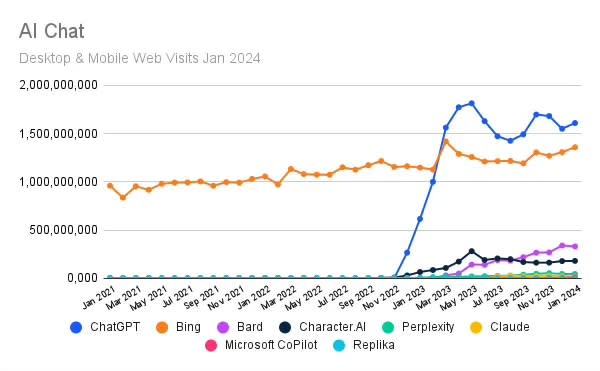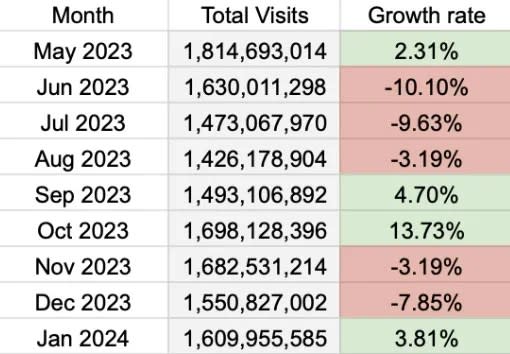ChatGPT’s Growth Is Flatlining
ChatGPT is stagnating. The megahit chatbot from OpenAI has seen declining web traffic in five of the past eight months and is currently down 11% from its May 2023 peak. Its mobile app, meanwhile, is going nowhere fast, with fewer total users than Snapchat added last quarter alone.
The new data, from analytics firm Similarweb, indicates OpenAI’s post-ChatGPT era is arriving faster than many anticipated. Though OpenAI initially envisioned the bot as a demo for its GPT models, it quickly grew into something much larger, leading to big dreams about what it could be. Now, as growth tails off, the company will have to press harder on its other efforts, and ask why its flagship product couldn’t sustain its rapid acceleration.
“As much attention as they’ve attracted, ChatGPT is still not mainstream,” David Carr, senior insights manager at SimilarWeb, told me.
Here’s what the data looks like and what it means:
ChatGPT hit its traffic peak in May 2023 with 1.8 billion web visits, but tailed off during the summer. By August 2023, visits were down 21% from its high and they haven’t recovered since. Some explained away the summer dip as a temporary pause due to students leaving school, but after an early-fall rally, ChatGPT usage dropped by more than 3% in November and 7% in December. In January 2024, its 1.6 billion visits amounted to an 11% decline in traffic from its peak and stagnant growth since mid-2023. These numbers are big, but for scale: Bing, with just 3.4% of the global search market, received 1.3 billion visits in January.

ChatGPT’s mobile app, meanwhile, hasn’t taken off. The app debuted with 4.3 million U.S. users in July 2023 but only increased to 6.3 million U.S. users by January 2024. Snapchat, by comparison, added 8 million daily users in the fourth quarter of 2023, growing from 406 million to 414 million.
OpenAI did not reply to a request for comment.
The stagnation of ChatGPT doesn’t suggest an end to OpenAI, but rather an imperative to evolve. The research house, which could be worth $100 billion, introduced an astounding video generation model called Sora on Thursday that shows a way forward. In an ultra-competitive AI race, where Google’s Gemini just equaled GPT-4’s capabilities, OpenAI will have to pump out hits to stay ahead. Sora, which drew rave reviews as OpenAI CEO Sam Altman demonstrated its capabilities on X, is exactly that type of innovation.

And while visions of a ChatGPT platform — where developers build plugins for users to interact with within the bot — may prove elusive, the central GPT technology is still core to OpenAI’s business. The company has sold access to GPT models to enterprises — netting some $2 billion in annualized revenue — to enable them to build smaller, use-case specific bots and features like natural language search within their products. OpenAI is also reportedly developing AI agents, which might take over machines and perform actions like filling out expense reports, a major push that could maximize its current technology’s value.
As OpenAI’s models get better, ChatGPT will also get better, giving it a chance to grow over time. The company is currently working on a fix to one of the most frustrating aspects of ChatGPT — its goldfish memory — by building in better recall capabilities. Not having to teach the bot who you are after each login should be a relief to power users.
Big, general purpose chatbots might also just have a ceiling as a user interface, something that’s loomed over ChatGPT from the start. OpenAI should be fine if this is the limit, but certainly disappointed if its revolutionary application can’t push beyond the current threshold.
The post ChatGPT’s Growth Is Flatlining appeared first on TheWrap.

